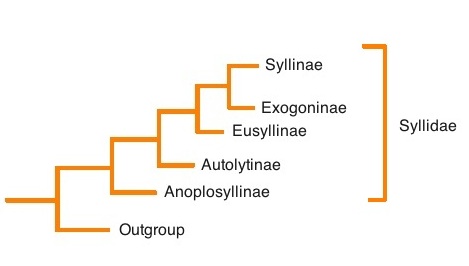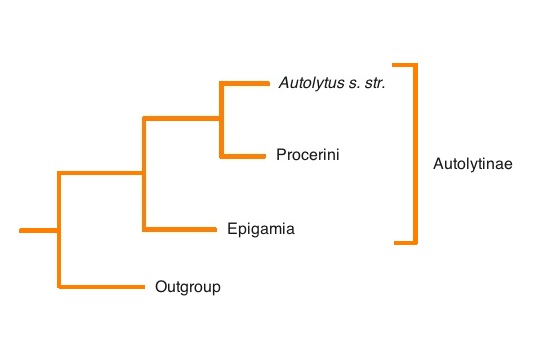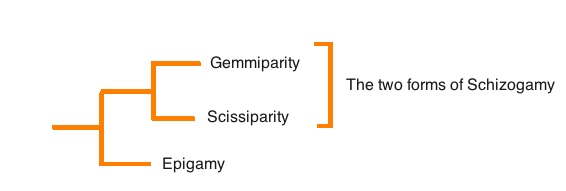Evolution & Systematics
As mentioned in the Summary, Myrianida pachycera is of the family Syllidae, the sub-family Autolytinae and the genus Myrianida. Its greater phylogenetic placement is shown in the panel to the right.
The diversity in Syllid reproductive strategies has proven an important and informative tool in the construction of phylogenetic relationships at the family and sub-family levels (eg. Nygren, 1999; Nygren & Sundberg, 2003; Aguado et al., 2007; Nygren & Pleijel, 2007; Aguado et al., 2012). Molecular and morphological data have also proven invaluable in building and supporting these phylogenies (Nygren & Sundberg, 2003; Aguado et al., 2012). The monophyly of the family Syllidae is strongly supported (Figure 1; Aguado et al., 2012) as is the monophyly of Autolytinae (Figure 2; Nygren & Sundberg, 2003; Aguado et al., 2012).

|
|
Figure 1 Phylogenetic relationships of the sub-families within the polychaete family Syllidae. The genus Myrianida is placed in Autolytinae. Adapted from Aguado et al. (2012).
|
The study by Nygren & Sundberg (2003) was the first, and is currently the last, phylogenetic study of Autolytinae, and it identified three strongly supported clades within the sub-family: Epigamia, which includes the epigamous taxa of Autolytus; Procerini, which includes taxa exhibiting anterior scissiparity; and Autolytus s. str., which includes all Myrianida, along with other Autolytus taxa that exhibit posterior schizogamy. The relationship between the three clades was uncertain, however the analysis supported Epigamia as most basal, with Procerini and Autolytus s. str. as potential sister groups (Figure 2).

|
|
Figure 2 Potential phylogenetic relationship of three distinct clades within the sub-family Autolytinae. The genus Myrianida is placed in Autolytus s. str. Adapted from Nygren & Sundberg (2003).
|
In regards to the evolution of reproductive strategies, strong support was given by Nygren & Sundberg (2003) for epigamy as the ancestral reproductive state of Autolytinae. Gemmiparity was thought to be most likely derived from scissiparity rather than the other way around, though this hypothesis was not conclusively supported. A more recent study by Aguado et al. (2012) gave strong support for the proposed relationship between the Autolytinae clades, and as such, for the evolution of the different reproductive strategies (Figure 3).

|
|
Figure 3 Supported evolution of reproductive strategies in the sub-family Autolytinae, with gemmiparity being a derived form of scissiparity.
|
|